
Pubblicato il 8th May 2018
Modificato il 17th Nov 2025
Qual è la differenza tra la fessurazione e la rottura di un opale?
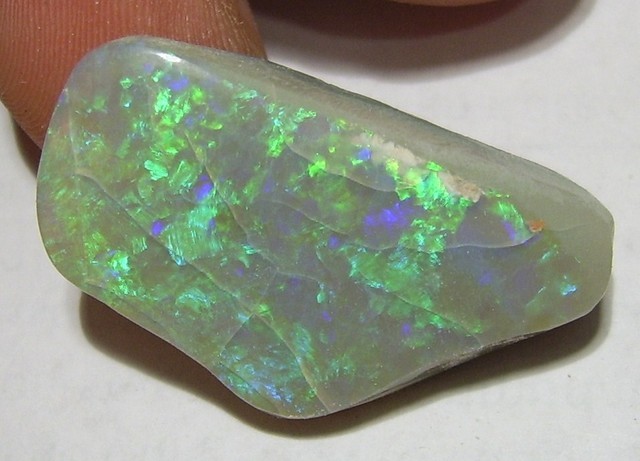 Molti tagliatori di opali vendono pietre con crepe o screpolature. C'è una differenza sostanziale tra le due e vi mostreremo di cosa si tratta. Sebbene non ci sia nulla di male nell'acquistare un opale screpolato o incrinato, è importante che l'acquirente ne sia informato prima dell'acquisto. Se il vostro opale presenta linee di frattura o presenta delle crepe, non immergetelo in un pulitore a ultrasuoni, poiché potrebbe danneggiarsi.
Molti tagliatori di opali vendono pietre con crepe o screpolature. C'è una differenza sostanziale tra le due e vi mostreremo di cosa si tratta. Sebbene non ci sia nulla di male nell'acquistare un opale screpolato o incrinato, è importante che l'acquirente ne sia informato prima dell'acquisto. Se il vostro opale presenta linee di frattura o presenta delle crepe, non immergetelo in un pulitore a ultrasuoni, poiché potrebbe danneggiarsi.
CREPE

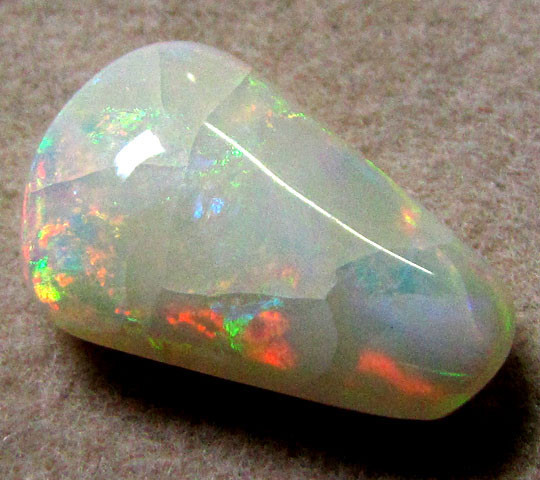
Una crepa può essere una faglia minore o maggiore. Può essere superficiale o interna. Se si vede una linea all'interno dell'opale e riflette la luce, allora si tratta di una crepa nella pietra. Le crepe esterne ne diminuiscono il valore/prezzo più di quelle interne.
È stato dimostrato che le crepe interne sono stabili e non continuano a crescere. Alcuni minatori di opale hanno pietre con crepe al loro interno che non hanno subito alcun movimento. Le linee di frattura esterne in un opale lucidato possono essere tagliate, ma ovviamente questo ne riduce le dimensioni e il valore.
Gli opali crepati non sono necessariamente destinati a rompersi. Molti opali crepati resistono, ma il problema più grande è che se un opale è crepato e inserito in un anello, l'usura quotidiana e gli urti possono romperlo. Molti opali crepati vengono incastonati come pendenti per questo motivo e possono essere indossati per la maggior parte del tempo.
SCREPOLATURA
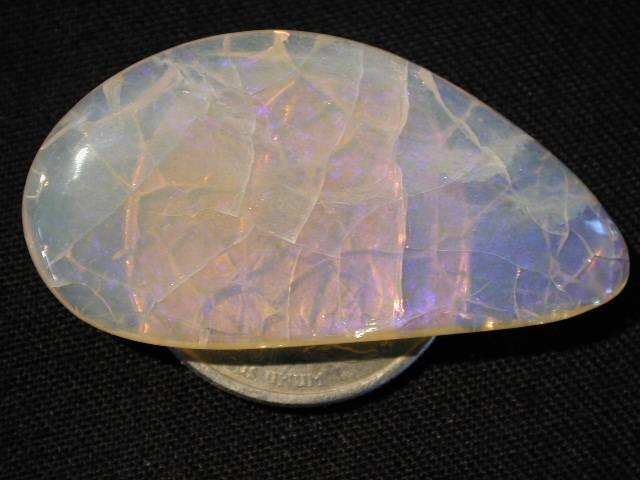
Le screpolature si presentano come molteplici linee di frattura. Gli opali screpolati vengono per lo più conservati come esemplari o pezzi da collezione. Non sono raccomandati per l'uso in gioielleria. Gli opali screpolati possono essere trattati con Opticon, che ne stabilizza l'aspetto.

L'immagine sopra è un opale etiope con un'inclusione. Notare che non c'è alcun riflesso di luce.
Le inclusioni non sono crepe. Molti opali contengono inclusioni naturali. Possono essere bolle d'aria, materiale vegetale e persino potch.
OPALE AUSTRALIANO
La maggior parte degli opali australiani è molto stabile, con l'opale nero [N1] considerato il più stabile grazie alle sue molecole più piccole. Generalmente, l'opale australiano che presenta una crepa ha un valore pari al 10-20% di quello di un opale stabile di qualità simile. Si stima che solo l'1-3% circa degli opali australiani si crepi, ma alcuni campi di opali sono più suscettibili di altri.
La maggior parte degli opali australiani contiene il 3-5% di acqua. Generalmente, più in profondità scava il minatore, maggiore sarà il contenuto d'acqua dell'opale. Le miniere di Lighting Ridge scendono fino a circa 30 metri e il minatore può valutare la stabilità dell'opale. Quando il potch passa da materiale duro e asciutto a potch umido e fradicio, questo è indice di materiale stabile. Quando si scende più in profondità, il minatore sa che questo opale avrà ovviamente un contenuto d'acqua maggiore.
La maggior parte degli opali australiani non sono porosi e quindi non assorbono acqua.
LINEE POTCH

Alcuni opali possono presentare venature o linee a ragnatela. Queste non sono crepe, ma linee di potch. È facile per il tagliatore verificarle poiché le crepe riflettono la luce, ma le linee di potch no. Le linee di potch diminuiscono il valore dell'opale a seconda della loro intensità. Generalmente non influiscono sulla stabilità dell'opale.
OPALE ETIOPE
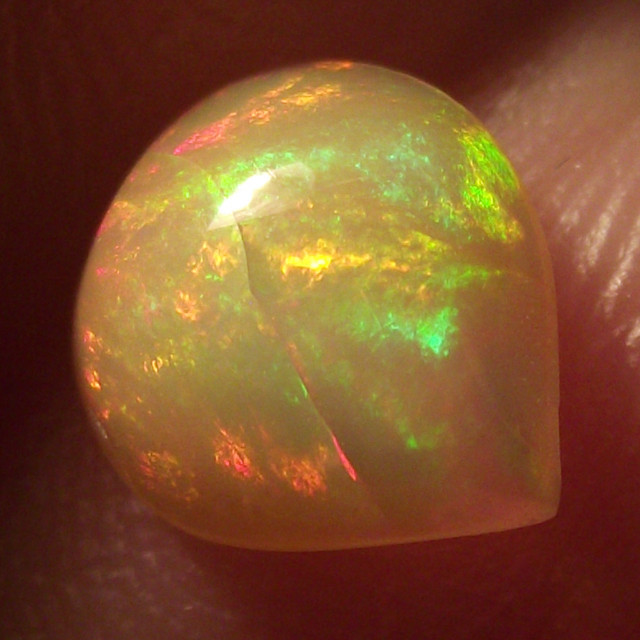

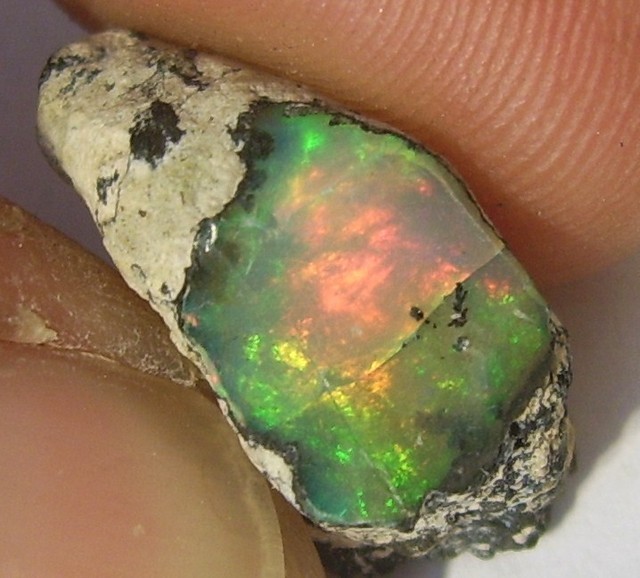
L'opale etiope è un opale idrofano . L'opale idrofano assorbe acqua. Quando l'opale etiope è disidratato, la base è più opaca. Quando l'opale è idratato, diventa più trasparente. Il tempo di transizione da idratato a disidratato può variare da minuti a giorni, ma la maggior parte degli opali effettua la transizione in poche ore.
TEST DI FRATTURA DELL'OPALE ETIOPE
Le pietre preziose vengono sottoposte a prove di frattura o clivaggio da secoli per testare la presenza di fenditure o sfaldamenti nel materiale grezzo. Tutti i principali centri di intaglio o taglio eseguono prove di frattura del materiale prima di procedere al taglio o all'intaglio.
Anche prima dell'invenzione delle moderne tecniche di collaudo, il materiale grezzo veniva ancora testato. Durante l'inverno, un fuoco di legna riscaldava una stanza e l'acqua fredda veniva ripetutamente spruzzata sul materiale grezzo.
Oggi questo processo di base è ancora utilizzato per gli opali, immergendoli in acqua e asciugandoli in un ambiente caldo ma non bollente. Questo processo può essere ripetuto più volte prima di iniziare il taglio. Alcuni opali con una piccola fessura possono talvolta espandersi sott'acqua.
Questo processo verifica i punti di stress e si formeranno delle crepe nel punto di sfaldatura più debole. L'opale è ora pronto per essere tagliato e lucidato per rimuovere eventuali crepe visibili.
Le fratture, le screpolature e le crepe possono presentarsi come:
- modelli zuccherini granulari
- pause lisce e uniformi
- rotture irregolari con bordi irregolari
I tagliatori ovviamente decidono di tagliare un opale dopo averlo sottoposto a test di frattura, per osservare su quale lato dell'opale si è verificata la frattura. Questo richiede grande abilità e un tagliatore professionista taglierà seguendo le indicazioni che si sono formate una volta completata la frattura.
Ci vogliono molti anni di esperienza per capire qual è il metodo migliore per tagliare un opale. I tagliatori esperti di opali applicano una percentuale di taglio per le pietre di qualità superiore dal 3 al 5%, e nella maggior parte dei casi ne vale la pena!
STABILIZZAZIONE OPTICON
Opticon è il metodo più comune per stabilizzare l'opale. Immergere le pietre in un barattolo di vetro riempito con Opticon in quantità sufficiente a ricoprirle completamente e chiudere il coperchio in modo che l'acqua non possa fuoriuscire. La condensa può rendere la resina torbida.
- Mettere il barattolo in una normale pentola a cottura lenta, riempita con acqua sufficiente a evitare che galleggi.
- Alzare la temperatura a 150-170 gradi Celsius (302-338 gradi Fahrenheit)
- Utilizzare un termometro per controllare la temperatura. Si consiglia di utilizzare un termometro da cucina per carne.
- Cuocere per 24 ore
- Filtrare la resina in eccesso e posizionarla su un foglio di alluminio
Utilizzare una macchina per il sottovuoto, come quelle usate per i sacchetti per alimenti. Questa aspira l'aria dal sacchetto.
- Passare l'aspirapolvere per almeno un'ora.
- Utilizzando un pennello da artista, dipingere la pietra con una miscela debole [40 a 1] di resina e indurente e aspirare nuovamente per 15 minuti.
- Rimuovere l'umidità in eccesso con un panno imbevuto di acetone.
- Quando le pietre non sono più appiccicose, lucidarle o rilucidarle
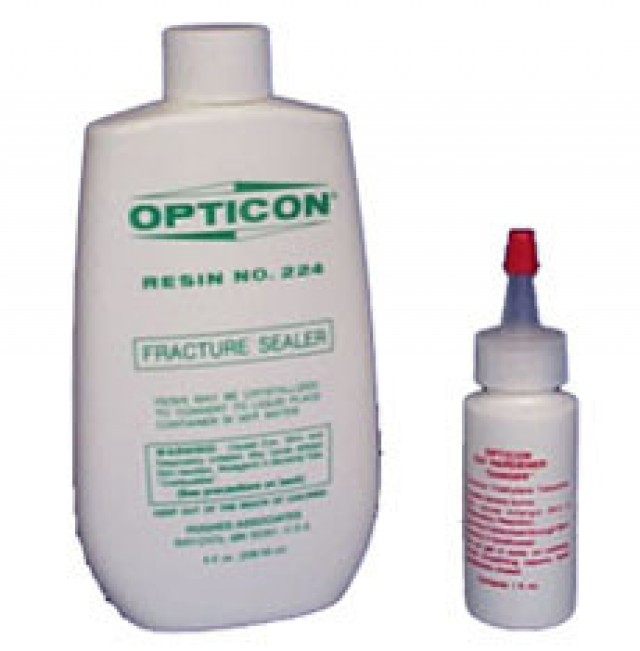

Questo opale arlecchino da 54,7 carati è stato venduto per oltre 1.100 dollari. Quando è stato tagliato 5 anni fa, presentava delle crepe. Il proprietario ha trattato la pietra con Opticon e l'ha venduta a circa il 10% del suo valore se non trattata.
COLLE
Puoi anche ricoprire la pietra con della supercolla e riscaldarla sotto una luce intensa. Il rivestimento simile al vetro sulla pietra le conferisce stabilità durante la lucidatura.
OPALE BOULDER
L'opale Boulder si forma principalmente su un supporto di minerale di ferro ed è stabile. Questo minerale di ferro può avere un colore che va dal marrone cioccolato intenso al color sabbia con un colore marrone chiaro. Il minerale di ferro aiuta a mantenere stabile l'opale. Alcune linee di frattura possono apparire a un'angolazione del 45%, ma l'opale può comunque essere stabile. Anche alcuni cristalli di opale Boulder possono presentare delle crepe. I campi di opale Koroit e Yowah sono considerati stabili.
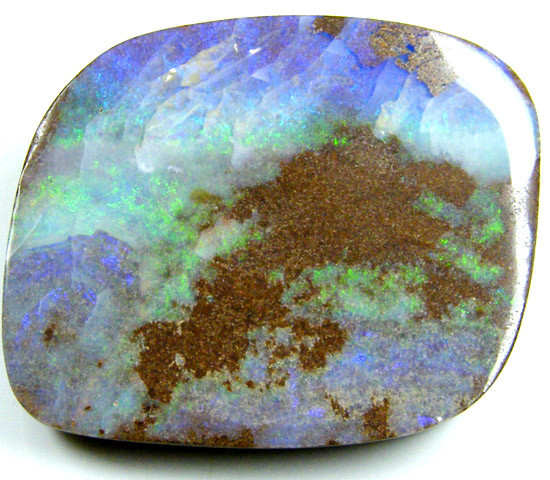

OPALE MESSICANO
La maggior parte degli opali messicani è stabile. Opali screpolati o incrinati possono verificarsi quando il potch e l'opale vengono tagliati in un unico pezzo, poiché ciascuno ha una soglia di pressione diversa.


OPALI USA
Gli opali americani non sono generalmente considerati stabili e vengono per lo più realizzati in triplette o stabilizzati. Gli opali americani tendono a screpolarsi poiché il contenuto d'acqua può arrivare fino al 14%.
OPALI BRASILIANI
Sono generalmente considerati stabili poiché il contenuto d'acqua è solitamente inferiore al 5%. Gli opali sono semitrasparenti o bianco-trasparenti.
OPALE DELL'HONDURAS
L'opale dell'Honduras sulla matrice è considerato stabile, ma alcuni cristalli formati sulla matrice possono presentare linee di fessurazione
Sfoglia i nostri opali
Cerca il Opal Encyclopedia
Aste correlate
articoli Correlati
Tabella di conversione per le misure degli anelli
17th Jul 2018
L'opale Boulder è uno degli opali più sottovalutati sul mercato. Scopri di più su questo opale unico e scopri le splendide pietre che abbiamo in vendita.
29th May 2019
Con la passione per gli opali, Wayne ed Estella Sedawie hanno fondato Opal Plus più di 14 anni fa e hanno scoperto che internet è uno strumento prezioso. È qui che avviene la maggior parte delle transazioni internazionali dell'azienda.
17th Oct 2018
Articoli Recenti
Scopri come vengono classificati gli opali e quali fattori ne influenzano il prezzo. Dal colore alla brillantezza, dal taglio all'origine, scopri come viene valutato ogni tipo di opale, con esempi di fasce di prezzo.
19th Jul 2023
Venite a scoprire il potere curativo degli opali con la nostra scrittrice ospite Vivien Schapera di Crystal Healing Techniques!
20th May 2023
L'opale "Regina di Fuoco" è l'opale più costoso al mondo, venduto per l'equivalente moderno di 3 milioni di dollari. Scoprite tutto sulla sua storia e sulle sue qualità!
18th Feb 2023
Categorie di articoli
All there is to know about Opals including Black Opals, Ethiopian Opals & Boulder Opal
14 Articoli
Check out our fascinating information and articles on all things amazing in the Opal world
41 Articoli
Opal Auctions sellers who are approved as opal Verified Sellers
4 Articoli








